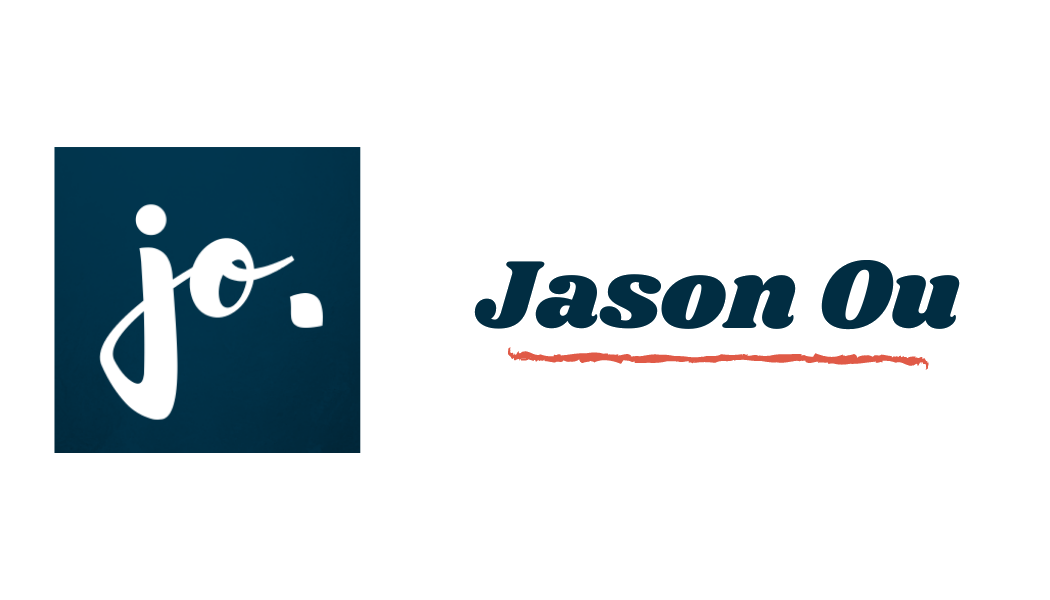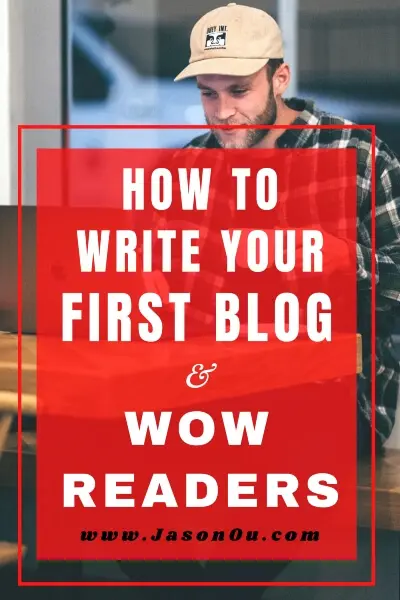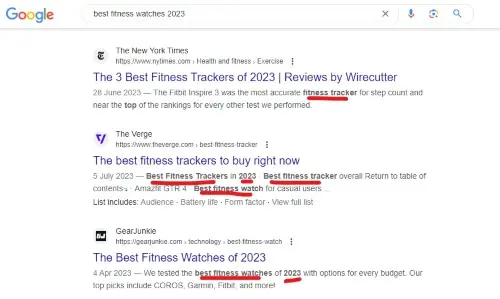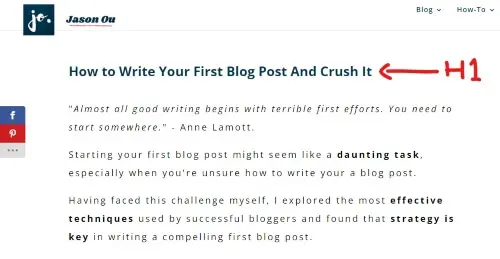How to Write Your First Blog Post And Crush It
“Almost all good writing begins with terrible first efforts. You need to start somewhere.” – Anne Lamott.
Starting your first blog post might seem like a daunting task, especially when you’re unsure how to write your first blog post.
Having faced this challenge myself, I explored the most effective techniques used by successful bloggers and found that strategy is key in writing a compelling first blog post.
In this article, we will discuss everything from understanding your purpose and identifying your target audience to SEO basics and promoting your content.
Stay tuned for an essential roadmap that will guide you through the process of writing an engaging first blog post with ease!
Key Takeaways
- Understand the purpose of your blog and identify your target audience to shape your content and writing style.
- Select a unique topic within your niche that hasn’t been extensively covered, and include low-competition keywords for better visibility on search engines.
- Familiarize yourself with SEO techniques like keyword research and incorporating LSI keywords to improve your blog’s visibility.
- Craft an engaging blog post by including elements such as a captivating headline, clear outline, relevant visuals, internal links, and a strong call-to-action.
9 Tips to Writing Your First Blog Post
I’m not going to sugar-coat this. But your first blog post will be the hardest. It’s not going to be perfect. And it’s not going to be your best work. However, as you clock up your blogging experience, you’ll be able look back, frown and edit that first blog post. That is the nice part about blogging. You can always rework and update your blog. On that note. Here’s how to write your first blog post.1. Understanding the Purpose of Your Blog
Save/Pin the image below👇because I often update my posts. So stay informed with this blog “How to Write Your First Blog Post” and save it.
This page have some affiliate links. In other words, if you buy from my links, I may get a commission. And some of the images were sources from Unsplash+ (Getty Images, Thought Catalog, Jason Strull).
Defining the purpose of your blog is a crucial first step.
This means understanding why you’re blogging and what you hope to achieve with your content.
Maybe you see blogging as a creative outlet, or perhaps it’s part of a broader business strategy.
Either way, it directly influences the topics you’ll write about, the tone of your words, and how often you’ll need to post.
Knowing what drives your blog also helps shape its identity and voice.
If consistency in blogging is key for long-term results, then having clear objectives will ensure every post aligns with those goals.
It’s not just about generating leads either.
Blogs offer an opportunity to educate readers, answer burning questions within your niche topic and even create an engaged community around shared interests or experiences.
2. Identifying Your Target Audience
Knowing who you’re writing for is a fundamental part of blogging.
It’s crucial to understand your target audience, their interests, concerns, and what they are looking to gain from reading your blog.
Identifying these factors can help shape not only the content but also the style of your writing.
Digging deep into demographics like age, location, gender, and occupation will provide valuable insights about the readership you’re likely aiming for.
Going a step further by investigating their hobbies or challenges might add an extra edge in connecting with them on a personal level.
It’s equally important to consider how your audience would perceive your topic choices.
Will it answer their burning questions? Does it align with their curiosity or needs?
All this information becomes critical when planning out posts that captivate and retain an audience effectively.
Being attentive to such nuances won’t just elevate your reader engagement but also create loyal followers eager for every new post you publish.
3. Selecting Your First Blog Topic
When it comes to selecting your first blog topic, brainstorming ideas and recognizing the best opportunity is key.
Discover how to choose a topic that captures your audience’s attention and keeps them coming back for more by reading on.
Brainstorming First Blog Post Ideas
I want to make it clear: brainstorming is a vital step in beginning your first blog post journey.
- Jot down all of your ideas without filtering them out. Anything that comes to mind should be written down.
- Think about the problems your target audience may face, an effective post could offer solutions.
- Prioritize blogging topics and questions that stir your passion, this will shine through in your writing.
- Do research within your niche topic, it can open up fresh perspectives and new ideas for blog posts.
- Utilize tools like Google Trends or Buzzsumo to analyze what’s currently trending in your area of interest.
- Search for long tail keywords related to your niche as these often indicate what users are currently curious about.
Recognizing the Best Opportunity
When selecting your first blog topic, it’s important to recognize the best opportunity. Consider choosing a specific problem within your niche that hasn’t been extensively covered yet.
By addressing a unique and relevant issue, you can provide valuable insights and attract readers who are searching for answers.
Remember, picking a general problem gives you the chance to showcase your expertise while also standing out from the competition.
Additionally, including a low-competition keyword in your post can help improve its visibility on search engines like Google.
So seize the opportunity to create compelling content that fills a gap in the market!
4. Give Keyword Love to Your First Blog Post
In order to optimize your blog post for search engines, keyword research is crucial. This involves identifying opportune keywords and understanding the importance of incorporating LSI keywords.
By using strategic SEO techniques, you can increase your blog’s visibility and attract more readers.
Identifying Opportune Keywords
When crafting your first blog post, it’s crucial to identify opportune keywords that will help your content rank higher in search engine results.
By including low-competition keywords in your post, you can increase the chances of Google understanding and indexing your content effectively.
This will ultimately drive more traffic to your blog and attract potential readers who are searching for topics related to your niche.
Researching and incorporating relevant keywords into your blog post is an important aspect of SEO (Search Engine Optimization) that can greatly impact the success of your blogging journey.
You can use keyword tools like SE Ranking, Serp Watcher or even the Ahrefs Free Keyword Generator to find your keywords for the first blog post.
But.
Make sure to choose keywords that align with the interests and needs of your target audience.
Because his will increase the likelihood of attracting organic traffic and generating leads for future growth.
(Again. Keyword research is important. And it one part of the SEO game. I’ll dive into that later down this blog post)
Understanding LSI Keywords
LSI keywords are an essential aspect of SEO when writing your first blog post.
You might be wondering, “What exactly are LSI keywords?”
Well, LSI stands for Latent Semantic Indexing, which is a fancy way of saying that these keywords help search engines understand the context and relevance of your content.
In simpler terms, they’re words or phrases related to your main keyword.
By including these relevant LSI keywords in your blog post, you’ll not only improve your chances of ranking higher in search engine results but also provide valuable information to your readers.
And the good news.
Finding LSI keywords for your first blog post doesn’t necessarily require fancy SEO software.
Think Google.
Here’s what you do:
Perform a search for your selected topic, along with your blog post title if you have one.
When you search on Google, you may notice certain words in bold within the search results.
So, what does this tell you?
Google is identifying those words as significant in relation to your topic.
To find additional search terms related to your query, scroll to the bottom of the search results page and look for the “Related searches” section.
Below, you will find bolded semantically similar words and phrases that other users have searched for.
In the “Related searches” section, you will find some keywords that have the same meaning as the one you searched but are phrased differently.
Also, some other keywords are slightly different. And it would be beneficial to include them in your article.
So. Let’s say, you’re writing your first blog post about the best fitness watches.
I would suggest including information about the minimalist fitness tracker.
Because. This is a related search identified by Google, indicating that your audience is likely interested in this topic.
And if you know anything about using a minimalist fitness tracker, then it could be worth your while to write a blog post about it.
By including these relevant LSI keywords in your blog post, you’ll not only improve your chances of ranking higher in search engine results but also provide valuable information to your readers.
So make sure to sprinkle them throughout your content naturally for better SEO and greater visibility.
If you want to know how competitive it will be to rank your first blog post, you can use a keyword research tool. In this article, we’ve featured and compared the best keyword rank tracking software. Feel free to check it out.
5. Forget About Writing The Perfect Blog Post
Writing the perfect blog post can be intimidating, but it doesn’t have to be.
As a first-time blogger, it’s completely normal to feel anxious about getting everything just right.
However, it’s important to remember that your audience wants authenticity and relatability more than perfection.
One way to banish anxiety is by creating an outline or template for your blog posts. (More on that soon.)
Having a clear structure in mind can help you stay organized and focused while writing.
Additionally, brainstorming ideas beforehand will give you a solid foundation to work from.
Another key tip is to find your own unique voice and style of writing.
Don’t be afraid to let your personality shine through in your blog posts – this will help you connect with your readers on a deeper level.
Lastly, keep in mind that practice makes perfect.
Your first blog post might not be flawless, but each one you write will improve over time.
Remember that blogging is a journey, and no one expects you to have all the answers right away.
Your authentic voice and valuable insights are what will make your blog stand out from the rest.
So take a deep breath, banish those anxieties, and start writing!
6. Crafting an Engaging First Blog Post
This is how to write your first blog post.
It involves incorporating eight key elements, editing your post for readability and accuracy, and writing an engaging blog post.
Let’s look at each component in more detail below.
8 Elements Of A Blog Post
When crafting a blog post, it’s important to include these eight elements that will help engage your readers and make your content stand out:
- Captivating headline: Grab the attention of your audience with a compelling headline that entices them to click and read more.
- Relevant featured image: Include an eye-catching image that is relevant to your blog post topic to visually enhance your content.
- Introduction: Start off strong by introducing your topic and capturing the interest of your readers right from the beginning.
- Headers: Break up your content into sections with clear headers, making it easier for readers to navigate and find the information they’re looking for.
- Body: Provide valuable and informative content in the body of your blog post that addresses the needs and interests of your target audience.
- Visuals: Incorporate visuals such as images, videos, or infographics throughout your blog post to enhance understanding and engagement.
- Internal links: Include links within your blog post that direct readers to other relevant articles or pages on your website, encouraging them to explore further.
- Engaging call-to-action: End your blog post with a call-to-action that prompts readers to take a specific action, whether it’s leaving a comment, sharing the post on social media, or signing up for your newsletter.
Start Writing Your First Blog Post With an Outline
Creating an organized outline is crucial for crafting a well-structured and engaging blog post.
Here are the key steps to follow:
- Begin with a captivating headline that grabs the reader’s attention.
- Introduce your topic and the main point you want to communicate in the introduction.
- Break down your content into logical sections using subheadings.
- Write a clear and concise body paragraph for each subheading, focusing on one main idea per paragraph.
- Use tables, bullet points or numbered lists to make your information more easily digestible.
- Incorporate relevant visuals such as images, infographics, or charts to enhance understanding and engagement.
- Include internal links to other relevant blog posts or resources within your website.
- Conclude your blog post with a strong call-to-action that prompts readers to take further action.
What Does a Good Blog Post Look Like?
Choose Your Tone And Voice
When it comes to writing your first blog post, it’s important to choose a tone and voice that will resonate with your audience.
You want to engage your readers and make them feel like you’re speaking directly to them.
Consider the purpose of your blog and the interests of your target audience when deciding on the right tone.
Keep in mind that being authentic and relatable is key, so don’t be afraid to let your personality shine through in your writing.
By selecting the right tone and voice, you can connect with your readers on a deeper level and keep them coming back for more valuable content.
Remember, consistency in style will help build a loyal following over time.
Writing Your First Blog Post
Writing engaging content is crucial when it comes to crafting your first blog post.
You want to captivate your audience right from the start and keep them interested throughout.
To achieve this, focus on providing valuable information that is easy to read and understand.
Use a conversational tone and share personal experiences or anecdotes whenever possible.
Incorporate visuals such as images or videos to make your content more visually appealing.
Also, consider ending your blog post with a call-to-action, inviting readers to leave comments or share their thoughts.
By writing engaging content, you will be able to connect with your audience and create a memorable experience for them.
An Irresistible Blog Post Headline
This was mentioned earlier as one of the key elements of a blog post.
Crafting an irresistible headline is a crucial step in creating an engaging first blog post.
Your headline needs to grab the attention of your readers and make them eager to click on your post.
Consider using powerful words, posing questions, or offering intriguing promises in your headline.
Additionally, pairing it with a relevant featured image can further entice your audience.
And don’t forget to include an engaging call-to-action that encourages readers to take action after reading your post.
By putting effort into crafting an irresistible headline, you can increase the chances of attracting more readers and making a strong impact with your blog post content.
7. Editing Your First Blog Post
Editing is a crucial step in creating a high-quality blog post. It involves reading your post aloud, searching for overused words, shortening sentences for readability, and proofreading for errors.
With proper editing, you can ensure that your content is polished and error-free before publishing it to your audience.
Reading the Post Aloud
Reading the post aloud is an essential step in improving the readability and engagement of your blog post.
By speaking your words out loud, you can identify any awkward or confusing sentences, as well as spot areas where you can make improvements.
It also allows you to hear the flow of your writing and make adjustments to ensure that it sounds natural and engaging to your readers.
Reading aloud helps to catch errors and typos that may have been overlooked during the editing process, ensuring that your blog post is error-free and polished before publishing.
So take the time to read your post out loud – it’s a simple but powerful technique for enhancing the quality of your writing.
Searching for Overused Words
Editing is a crucial step in the blog writing process, especially when it comes to eliminating overused words. Overusing certain words can make your blog post sound repetitive and less engaging.
To ensure that your content remains fresh and interesting, take the time to search for these overused words and find alternative ways to express your ideas.
This will help you create a more dynamic and compelling blog post that will captivate your audience’s attention.
So, be vigilant in identifying those overused words and replace them with stronger, more impactful alternatives.
Shortening Sentences for Readability
Shortening sentences is crucial for readability in blog posts. When sentences are too long, they can become confusing and difficult to follow.
And, shorter sentences help to break up the text and make it easier for readers to digest the information.
By shortening your sentences, you can ensure that your blog post flows smoothly and is easy for your audience to understand.
Remember, creating clear and concise sentences improves the chances of reader engagement with your blog post.
So take the time to review your writing and look for opportunities to trim down long-winded or convoluted phrases.
By doing this, you’ll enhance the quality and clarity of your content, making it more enjoyable for your readers.
Read this if you want to know How to start a Bluehost WordPress blog in 20 minutes.
Proofreading for Errors
Proofreading your first blog post is an essential step in ensuring its quality. It’s important to catch any errors or mistakes that might have been overlooked during the writing process.
By reading your post aloud, you can identify areas that need improvement and make necessary changes.
Search for overused words and replace them with more impactful alternatives. Shortening sentences for readability will also help engage your audience better.
Lastly, proofread carefully to eliminate any grammar or spelling errors before publishing your blog post.
8. How to Write Your First Blog Post With On-Page SEO
In order to optimize your blog post for search engines and increase its visibility, it’s crucial to familiarize yourself with SEO techniques.
This includes identifying opportune keywords, understanding the importance of LSI keywords, utilizing meta titles and descriptions, optimizing header tags and image file names, and crafting a reader-friendly slug URL.
By diving into the world of SEO, you’ll be able to drive more traffic to your blog post and attract a larger audience. Keep reading to learn more about how to master this essential skill.
Meta Does Matter
Meta titles and meta descriptions are essential elements of your blog post that can significantly impact its visibility in search engine results.
When crafting your meta title, it’s important to accurately describe the content of your blog post concisely.
By using relevant keywords in your meta title, you increase the chances of attracting organic traffic to your blog.
Additionally, writing compelling meta descriptions is crucial as they provide a brief summary of your blog post and entice readers to click on the link.
Remember, by optimizing these elements with relevant keywords and engaging descriptions, you can improve SEO and drive more traffic to your blog.
Header Tags
Header tags are an essential part of optimizing your first blog post for search engines.
When you use header tags, it helps search engines understand the structure and hierarchy of your content.
Additionally, it makes it easier for readers to navigate through your blog post and find the information they’re looking for.
Using header tags also has SEO benefits
By including relevant keywords in your headers, you can signal to search engines what your blog post is about.
This can help improve your chances of ranking higher in search engine results pages.
Remember, when using header tags, be sure to follow a logical order with H1 being the main heading and subsequent headers (H2, H3) representing subheadings or sections within your blog post.
This not only organizes your content but also enhances readability and user experience.
Blog Post Content
When crafting the body and content of your blog post, remember to keep it engaging and informative. Use short sentences and active voices to make it easier for your readers to follow along.
Include relevant facts or statistics from reliable sources to add credibility to your content. Make sure your paragraphs flow smoothly, using transition words like “furthermore” or “in addition.”
Don’t forget to include visuals such as images or graphs that support or enhance your message.
Finally, avoid a long wrap-up at the end; instead, conclude with a strong call to action that encourages readers to engage further with your blog post.
Optimize Your Images
This is often overlooked. And you shouldn’t too.
Labeling image file names with your keywords and then optimizing them is an important step in enhancing the SEO of your blog post.
It helps search engines understand and index your content effectively. Here are some key points to keep in mind:
- Use descriptive file names: Instead of using generic names like “IMG_1234.jpg,” rename your image files to reflect their content. For example, if you have a picture of a dog, use a file name like “happy-golden-retriever.jpg.”
- Include relevant keywords: Incorporate relevant keywords into the image file name to improve its visibility in search engine results. If you’re writing a blog post about healthy recipes, consider using keywords like “healthy_food” or “nutritious_dish” in the image file name.
- Separate words with hyphens: When labeling your image file names, use hyphens (-) to separate individual words. This helps search engines recognize each word as separate and improves readability for both users and search engines.
- Optimize alt text: Alt text is a brief description of an image that appears when the image fails to load or cannot be seen by visually impaired users. Include relevant keywords in the alt text to further optimize your images for search engines.
- Compress images for faster loading times: Large image files can slow down your website’s loading speed, which can negatively impact user experience and SEO rankings. Use compression tools or plugins to reduce the file size without sacrificing quality.
- Add captions when necessary: Captioning your images not only provides additional context but also gives you another opportunity to include relevant keywords and enhance the overall SEO of your blog post.
Slug URL
When publishing your first blog post, one important aspect to consider is the slug URL.
A slug URL is the part of the web address that identifies and describes your blog post. It should be concise, relevant, and include keywords related to your content.
By using an optimized slug URL, you can make it easier for search engines to understand what your post is about and improve its visibility in search results.
For example, this blog post you’re reading now is about “how to write your first blog post“. A good slug URL could be something like “how-to-write-your-first-blog-post”
Creating an effective slug URL is just one element of optimizing your blog posts for better search engine ranking and attracting more readers.
To learn more about how to effectively utilize SEO in your blog posts, read this post on the best blogging best practices for creating a thriving blog.
Don’t Miss This:
9. Publishing Your First Blog Post
Choosing the Right Platform provides a solid foundation for your blog, allowing you to showcase your content in an appealing and professional manner.
And using Images intentionally can enhance the visual appeal of your post and catch the reader’s attention.
Including a Call to Action at the end encourages reader engagement and interaction.
Learn more about publishing strategies in this section!
Choosing the Right Platform
Choosing the right platform for publishing your first blog post is a crucial decision.
It should align with your long-term needs, business goals, and customer preferences.
Consider platforms that cater to blogging beginners and provide user-friendly interfaces.
Keep in mind that certain platforms like Pinterest may not be effective for promoting your first blog post.
Also, it’s important to note that your first blog post may not easily be discoverable through Google searches, so choose a platform that allows you to optimize your content for search engines.
Lastly, keep in mind that as you continue to publish more posts, your first blog post may get lost among subsequent ones and be forgotten over time.
Write Your First Blog Post With Images
Including images in your first blog post is a great way to grab your readers’ attention and keep them engaged.
When used strategically, images can help break up long paragraphs of text and make your post visually appealing.
As well, relevant images can reinforce the main ideas you’re trying to convey and even provide visual examples or illustrations for better understanding.
Images can also increase the chances of your post being shared by readers, as they add value and make it more interesting.
So, don’t underestimate the power of using images intentionally in your blog posts!
Don’t Forget That Call to Action
Including a call to action in your first blog post is crucial. It’s the final push that encourages your readers to take action and engage with your content.
Whether it’s signing up for your newsletter, leaving a comment, or making a purchase, a well-crafted call to action can help drive traffic and boost conversions on your site.
Don’t underestimate its power! Remember, companies with blogs generate 67% more leads than those who don’t.
So make sure you include a clear and compelling call to action at the end of your post, guiding your readers towards the next step you want them to take.
How Do Bloggers Make Money Online
Promoting Your Blog Post
Promote your blog post by using social media platforms, leveraging SEO strategies, and implementing backlinking techniques.
Maximize your reach and engagement by sharing your post on various platforms and communities, such as Facebook, Twitter, and LinkedIn.
Optimize your blog post for search engines by incorporating relevant keywords throughout the content and utilizing meta titles, meta descriptions, header tags, image file names, and slug URLs.
Boost traffic to your blog by building quality backlinks from reputable websites in your niche. By actively promoting your post, you can increase its visibility and attract more readers to your blog.
Using Social Media
I highly recommend using social media to promote your first blog post. Sharing your post link across all social media platforms can help you reach a larger audience and drive traffic to your blog.
This is where understanding who your audience is comes to play. So, take the time to know where they hang out online and get out there to help them.
One platform that shouldn’t be overlooked is Pinterest, as it can be a significant source of traffic for blogs.
You can use tools like Tailwind to schedule pins and analyze the performance of your boards on Pinterest.
Another easy way to get more people to read your blog is by sharing your post in relevant categories on Reddit.
So don’t forget to leverage the power of social media in promoting your blog!
Leveraging SEO
Familiarizing yourself with SEO is crucial when it comes to getting your blog noticed by search engines.
By identifying opportune keywords and understanding LSI (latent semantic indexing) keywords, you can optimize your content for better ranking.
Including a low-competition keyword in your first blog post can help Google understand and index your content, increasing its visibility.
Additionally, using header tags, optimizing image file names, and crafting a slug URL are all important aspects of on-page SEO that can improve the readability and discoverability of your blog posts.
So, spend the time to research, optimize and leverage the power of SEO to attract more readers to your blog!
Backlinking Strategies
I learned some valuable backlinking strategies that can help promote my first blog post and increase its visibility.
Here are a few key tactics to consider:
- Reach out to other bloggers in your niche and ask for guest posting opportunities.
- Participate in relevant online communities and forums, leaving comments with a link back to your blog post.
- Create high – quality content that others will naturally want to link to and share.
- Utilize social media platforms to share your blog post and engage with your audience.
- Collaborate with influencers or experts in your industry, inviting them to contribute to or share your blog post.
- Take advantage of broken link building by finding broken links on other websites and suggesting your own relevant content as a replacement.
- Write compelling guest posts for popular blogs in your niche, including links back to your own blog post.
How to Get Your Blog Noticed With These 16 Proven Strategies
Final Advice on Writing Your First Blog Post
As a new blogger, my final advice to you is to stay consistent and persistent.
(Here’s an article where I delve deep on How Often You Should Post on a Blog so you can find a nice balance between quantity and quality.)
Building a successful blog takes time and effort, so don’t get discouraged if you don’t see immediate results.
Keep producing high-quality content that provides value to your audience. Don’t forget to promote your posts through social media and other channels to increase visibility.
Remember, SEO is important for attracting organic traffic, so make sure to familiarize yourself with keyword research and include relevant keywords in your posts.
And most importantly, enjoy the process!
Blogging should be a creative outlet that allows you to share your passions and connect with others in your niche.
So have fun writing your first blog post. And keep learning along the way!
Writing Your First Blog Post – FAQs
Still have question on writing your first blog post? Here are some common questions answered.
What should I consider when choosing a topic for my first blog post?
When choosing a topic for your first blog post, it’s important to consider your target audience’s interests and needs. You should also select a topic you are knowledgeable and passionate about, as this will make the writing process easier and more enjoyable.
How long should my first blog post be?
There is no set length for a blog post, but typically, it is recommended to aim for at least 500 words to provide enough substance and value to readers. However, the length can vary depending on the complexity of the topic and the style of writing.
Should I include images in my first blog post
Including images in your first blog post can enhance visual appeal and engage readers. Visuals help break up blocks of text and make the content more visually appealing. Ensure that any images you use are relevant to your topic and properly credited if necessary.
How do I promote my first blog post
To promote your first blog post, you can utilize various strategies such as sharing it on social media platforms like Facebook or Twitter, reaching out to friends or influencers who may be interested in sharing it with their audience, optimizing it for search engines by using relevant keywords throughout the content, or even collaborating with other bloggers or websites through guest posting opportunities.
How do you write a blog post for beginners?
Start with a clear idea and outline your thoughts. Write in a conversational tone, use visuals, and break the content into digestible sections. Don’t forget to edit and add your personal touch!
What should I write on the first page of my blog?
Your first page should introduce yourself and your blog’s mission. Share what topics you’ll cover and what readers can expect. A warm welcome and a glimpse of your personality can make a strong first impression.
What should I post first on my blog?
Begin with a post that resonates with your blog’s theme. Whether it’s a personal introduction, a tutorial, or a thought-provoking article, make sure it reflects your passion and sets the tone for future content.
How often should a beginner blogger post?
Consistency is key, but don’t overburden yourself. Starting with one post a week allows you to focus on quality and gradually build your audience. As you get comfortable, you can increase the frequency.
How to Write Your First Blog Post – The Wrap-Up
For sure, writing your first blog post can be a daunting task for beginners.
However, by understanding the purpose of your blog and identifying your target audience, you can select the right topic that resonates with them.
Familiarizing yourself with SEO techniques like keyword research and optimizing metadata will help make your blog post more visible to search engines.
Crafting an engaging blog post with a captivating headline, organized structure, and engaging content is crucial for capturing readers’ attention.
Remember to edit and proofread your post before publishing it, ensuring it is free from errors.
Once published, promote your post through social media and leverage SEO strategies to drive traffic to your blog. You’ll need it.
Finally, don’t forget to interact with your audience through comments and feedback
With these steps in mind, you are on your way to creating successful blog posts that captivate and resonate with readers in no time!
You Might Want to Check This Out Too
Disclosure: This post may contain affiliate links, which means I’ll receive a commission if you purchase through my links, at no extra cost to you. Please read full disclosure for more information.
Resources To Grow Your Business With
Bluehost
Bluehost is a great starting point for beginners or bloggers who want to switch to a reliable web hosting service. And it gives you the best bang for your buck - starting at $2.95 a month*.
With the entry-level hosting plan, you'll get a high up-time, reliable customer support, FREE domain name (first year) and 30 day money back guarantee.
You can sign up with Bluehost here.
WPX Hosting
It's a web-hosting service I love using. It specializes in WordPress hosting, and depending on what package you opt for, you can host 5 or more sites on one account. The best bit is - the quick turnaround in support is top notch.
For bloggers who have an established blog, this is a fantastic option.
You can learn more about this service here.
Aweber
Building an email list of a growing audience is essential for the longevity of any business. This autoresponder service is easy to use, and it is a great starting point for someone looking to kickstart their email campaign.
Hi, I’m Jason Ou (surname aka, Oh). I am a Solopreneur and Blogger. My mission is to help fellow entrepreneurs (like you) to profit from their passion online. Let’s connect on Facebook now.












